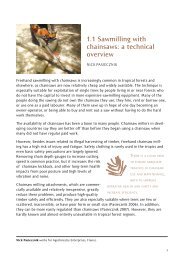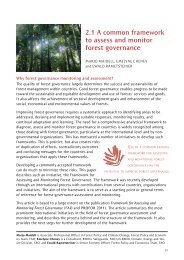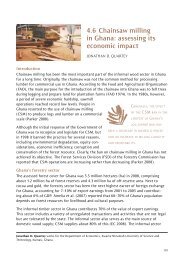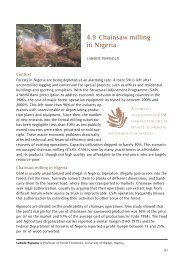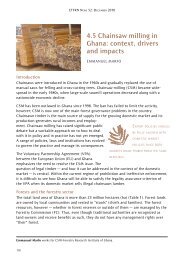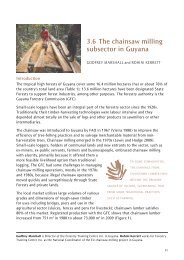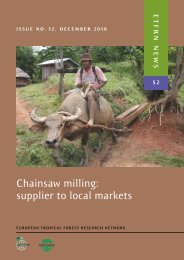Chainsaw milling: supplier to local markets - European Tropical ...
Chainsaw milling: supplier to local markets - European Tropical ...
Chainsaw milling: supplier to local markets - European Tropical ...
You also want an ePaper? Increase the reach of your titles
YUMPU automatically turns print PDFs into web optimized ePapers that Google loves.
114<br />
ETFRN NEws 52: DEcEmbER 2010<br />
3.9 chainsaw <strong>milling</strong><br />
in suriname<br />
RUDI VAN KANTEN and REWIE MATAI<br />
introduction<br />
<strong>Chainsaw</strong> <strong>milling</strong> (Csm) is underestimated in the government statistics that are<br />
maintained by the Foundation for Forest management and production Control (sbb)<br />
in suriname. an important part of the domestic timber market is supplied by Csm, both<br />
in production volume and source of income for forest dwellers and other people involved<br />
in the marketing chain. sbb also controls the timber<br />
<strong>markets</strong> but there are no exact figures on the extent<br />
The main problem<br />
of Csm timber in these <strong>markets</strong>.<br />
facing csm operaTors<br />
Forests and the forestry sec<strong>to</strong>r<br />
suriname has a population of approximately 520,000<br />
uncerTainTy of<br />
on 16.4 million hectares (ha) of land. The forest area<br />
covers approximately 90% of the country. The forest,<br />
which is considered under-utilized, contributes less<br />
than 2% <strong>to</strong> the Gross Domestic product (GDp), most of which comes from timber<br />
production and processing. The contribution of the forest sec<strong>to</strong>r is slightly higher if<br />
shifting cultivation and nature-related <strong>to</strong>urism are included.<br />
in suriname is The<br />
operaTions, wiTh no secure long-<br />
Term access To foresT resources.<br />
logging in suriname is restricted <strong>to</strong> an area known as the Forest belt within reach of road<br />
and river transport systems. within this area, which covers around 4.2 million ha, 2.2<br />
million ha are timber concessions; 1.5 million ha of these are issued <strong>to</strong> private entre-<br />
preneurs and 0.5 million ha <strong>to</strong> indigenous and tribal communities (Table 1).<br />
The country’s original inhabitants or amerindians (4% of the <strong>to</strong>tal population) and<br />
maroons (descendents of african slaves who successfully fought for their freedom; 12%<br />
of the <strong>to</strong>tal population) depend on the forest for their livelihoods. amerindians live in<br />
the savanna and maroons live along the major river basins. a considerable number of the<br />
amerindians and maroons live in the coastal area.<br />
rudi van Kanten is programme Direc<strong>to</strong>r, Tropenbos international suriname and rewie matai is Economist,<br />
Foundation for Forest management and production Control.



